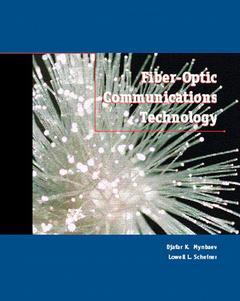Description
Fiber optic communications technology
Authors: MYNBAEV Djafar, SCHEINER Lowell L.
Language: English
Subjects for Fiber optic communications technology:
Approximative price 63.97 €
Subject to availability at the publisher.
Add to cart
Publication date: 12-2000
750 p. · 20.5x24 cm · Hardback
750 p. · 20.5x24 cm · Hardback
Description
/li>Contents
/li>Comment
/li>
- Embodying the dynamic nature of fiber-optic communications, this practical introduction takes a broad, up-to-date look at the industry, and fully prepares students for their future work in the field by providing a solid foundation in the basics with plenty of examples, graphical presentations, and solutions to problems that are similar to those found in the actual workplace. Enabling students to follow either a beginning or more advanced course of study for each chapter topic, it integrates many practical applications, presents the newest technological innovations in fibers, systems and networks, and integrates pictures of commercially available devices and equipment throughout.
(NOTE: Each chapter concludes with Summary, Problems, and References.)
1. Introduction to Telecommunications and Fiber Optics.
2. Physics of Light: A Brief Overview.
3. Optical Fibers-Basics.
4. Optical Fibers-A Deeper Look.
5. Singlemode Fibers-Basics.
6. Singlemode Fibers-A Deeper Look.
7. Fabrication, Cabling, and Installation.
8. Fiber-Cable Connectorization and Testing.
9. Light Sources and Transmitters-Basics.
10. Light Sources and Transmitters-A Deeper Look.
11. Receivers.
12. Components of Fiber-Optic Networks.
13. Passive Components, Switches, and Functional Modules of Fiber-Optic Networks.
14. An Introduction to Fiber-Optic Networks.
15. Conclusion.
Appendix A: List of Constants, Powers of Ten, International System of Units, Decibel Units, and the Greek Alphabet.
Appendix B: Acronyms, Abbreviations, Symbols, and Units Used in This Book.
Appendix C: A Selected Bibliography.
Appendix D: Products, Services, and Standards.
1. Introduction to Telecommunications and Fiber Optics.
2. Physics of Light: A Brief Overview.
3. Optical Fibers-Basics.
4. Optical Fibers-A Deeper Look.
5. Singlemode Fibers-Basics.
6. Singlemode Fibers-A Deeper Look.
7. Fabrication, Cabling, and Installation.
8. Fiber-Cable Connectorization and Testing.
9. Light Sources and Transmitters-Basics.
10. Light Sources and Transmitters-A Deeper Look.
11. Receivers.
12. Components of Fiber-Optic Networks.
13. Passive Components, Switches, and Functional Modules of Fiber-Optic Networks.
14. An Introduction to Fiber-Optic Networks.
15. Conclusion.
Appendix A: List of Constants, Powers of Ten, International System of Units, Decibel Units, and the Greek Alphabet.
Appendix B: Acronyms, Abbreviations, Symbols, and Units Used in This Book.
Appendix C: A Selected Bibliography.
Appendix D: Products, Services, and Standards.
- State-of-the-art coverage - Considers a wide range of pertinent topics in an insightful and informative manner.
- Exposes students to and familiarizes them with the latest commercially available innovations in technology, systems, and network levels that they are likely to see in the professional world. - Stimulating approach.
- Real data sheets - Concludes each topic with a discussion of specific data sheets, also provides specifications sheets as sources of data for making various calculations in the examples given, as an aid in explaining the material, and for solving different problems integrated throughout the text and assigned at the end of each chapter.
- Two-level discussion - Divides the discussion of most topics into two parts: a 'Basics' section introduces
© 2024 LAVOISIER S.A.S.




